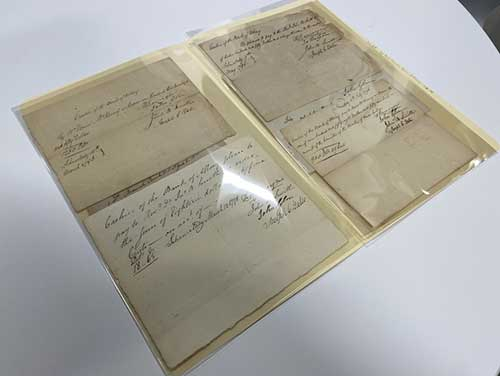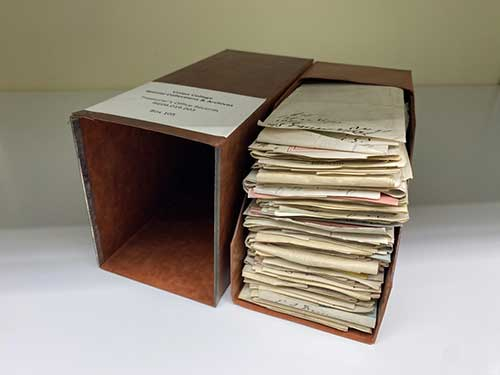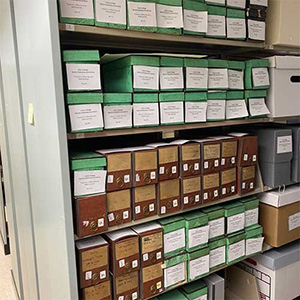A faded voucher from March 1798 for $18.65, which denotes the weekly paycheck for Union’s first president, John Blair Smith.
Records of purchases of shovels, pails and other building supplies associated with the construction of North and South College (now Minerva Houses), the first two original buildings that have served as residence halls since they opened in 1814.
Receipts for books, insurance and other expenses in the College’s formative years.
For decades, these rare documents that offer a fascinating window into the College’s early spending years were tightly folded and bundled in 75 small boxes that languished on the shelves in Special Collections.
Due to their fragility, the material was practically inaccessible to staff, let alone available to student researchers and historians.
Now, however, the public can get its first look at a broad sampling of the historic vouchers maintained by what was then known as the Treasurer’s Office.
In February, Special Collections sent three boxes of material covering a broad period to the Northeast Document Conservation Center in North Andover, Mass., for conservation analysis and treatment, said Joseph Lueck, outreach and reference archivist in Special Collections.
This includes vouchers from the 1790s, 1813-1814 (construction of North and South Colleges), and 1858-1859 (initial construction of the iconic Nott Memorial).
Conservators carefully unfolded the delicate documents and placed them flat in a humidification chamber. They eventually preserved most of the vouchers in mylar sleeves. The restoration, completed earlier this month, brought the vouchers back to a good and fully readable state.
“We’re very excited and happy with the content,” Lueck said. “There was always a chance the material could come back extremely dry or less interesting. But we are thrilled.”
Wayne Somers ’61, editor of the Encyclopedia of Union College History, said the documents are the key to creating a fuller and more accurate picture of Union's early years.
"The importance of these documents lies not just in what they tell us directly, but in what they imply," he said. "For instance, if the college bought shovels and pails, it was probably the de facto contractor. And if the workers pay is documented, with names, this could shed some light on the speculation that North and South Colleges were built with Black - and possibly slave - labor. The less evidence there is, the more intensely the existing evidence is studied."
Since it is expensive, Lueck described the process to conserve the material as a long-term project, with the goal of getting all 75 boxes with documents from 1790 to 1901 completed. The hope is to eventually digitize the material, as well.
In the meantime, Lueck and others are now sorting through the restored material to catalogue the inventory.
While they don’t expect to experience an aha moment - like when a rare lock of George Washington’s hair was found hidden in a long-forgotten book in Schaffer Library in 2018 - Lueck is anxious for student researchers to do a deep dive into the documents.
“This is basically a pile of expenditure data that students can mine,” he said. “This material unlocks core financial decisions that were made during the first 100 years of Union’s history.”


